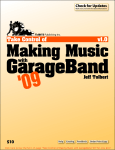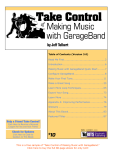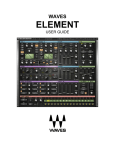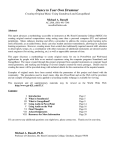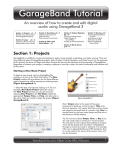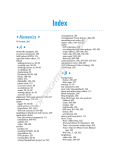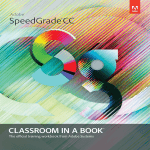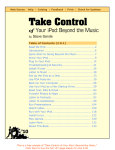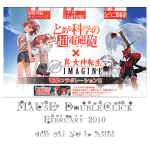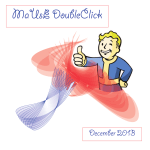Download Take Control of Making Music with GarageBand 08 (1.0)
Transcript
Web Extras: Help | Catalog | Feedback | Print | Check for Updates Take Control of Making Music with GarageBand ’08 by Jeff Tolbert Table of Contents (1.0) Read Me First .............................................. 2 Introduction ................................................ 5 Making Music with GarageBand Quick Start ..... 7 Configure GarageBand.................................. 9 Make Your First Tune.................................. 12 Make a Great Song .................................... 26 Transform a Magic GarageBand Song ........... 68 Learn More Loop Techniques ....................... 86 Export Your Song....................................... 94 Learn More................................................ 97 Appendix A: Improving Performance ............ 99 Glossary ................................................. 102 About This Book ...................................... 107 10 $ This is a free sample of “Take Control of Making Music with GarageBand ’08.” Click here to buy the full 110-page ebook for only $10! READ ME FIRST Welcome to Take Control of Making Music with GarageBand ’08, version 1.0, published in May 2008 by TidBITS Publishing Inc. GarageBand is an exceptional way for musicians and nonmusicians alike to unleash their musical creativity. This book shows you how to use loops, assemble them into a composition, mix the song, and use basic audio effects in GarageBand ’08 (part of Apple’s iLife ’08 suite), also known as GarageBand version 4. Even if you have no musical ability or instruments, you can create an impressive song quickly and easily. This book was written by Jeff Tolbert and edited by Caroline Rose. Copyright © 2008, Jeff Tolbert. All rights reserved. The price of this ebook is $10. If you want to share it with a friend, please do so as you would a physical book. Click here to give your friend a discount. Discounted classroom copies are also available. Updates We may offer free minor updates to this book, or discounts on major updates and new editions. If you have the PDF version of this title, you can read new information and find out about any updates to the PDF by clicking the Check for Updates link on the cover. On the resulting Web page, you can also sign up to be notified about updates to the PDF via email. If you have only the printed book, or if you’re reading this onscreen in a non-PDF format, contact us at [email protected] to learn about obtaining the PDF version. Basics In reading this book, you may get stuck if you don’t understand Take Control syntax for things like working with menus or finding items in the Finder. Please note the following: • Menus: Where I describe choosing a command from a menu in the menu bar, I use an abbreviated description. For example, the abbreviated description for the menu command that deletes a track from a song in GarageBand is “Track > Delete Track.” Page 2 This is a free sample of “Take Control of Making Music with GarageBand ’08.” Click here to buy the full 110-page ebook for only $10! • Path syntax: I occasionally use a path to show the location of a file or folder in your file system. Path text is formatted in bold type. For example, the default GarageBand installation puts the GarageBand demo songs in the /Library/Application Support/GarageBand folder. The slash at the beginning of the path tells you to start from the root level of the disk. Some paths begin with ~ (tilde), which is a shortcut for any user’s home folder. For example, if a person with the user name joe wants to install fonts that only he can access, he would install them in his ~/Library/Fonts folder, which is just another way of writing /Users/joe/Library/Fonts. • GarageBand’s Preferences: I sometimes refer to preferences in GarageBand that you may want to adjust. To display GarageBand’s preferences (not to be confused with the systemwide settings found in the System Preferences application), choose GarageBand > Preferences (Command-,). Within the Preferences window, click a button at the top to display a pane with that category of preferences (for example, the Audio/MIDI button). Instead of giving detailed directions each time, I sometimes use an abbreviated notation such as “go to the Audio/MIDI preference pane.” NOTE Listen as you learn! I occasionally give an audio example by linking to a song in the iTunes Store. You can click the link to connect to the iTunes Store and then double-click the song in the album list to play a 30-second preview of it. What’s New in This Edition This book is a new edition of Take Control of Making Music with GarageBand, which I first wrote for GarageBand 1.0. I’ve updated the book for each major new version of GarageBand so far. For this edition, I updated the book to cover new features in Apple’s latest upgrade to the program, version 4, as follows: • An extensive tutorial, Transform a Magic GarageBand Song (p. 68), takes you through using the new Magic GarageBand feature and customizing the resulting songs so that they don’t sound like everyone else’s. Page 3 This is a free sample of “Take Control of Making Music with GarageBand ’08.” Click here to buy the full 110-page ebook for only $10! • GarageBand 4 adds a new track called an arrange track to help you organize sections of your song. You’ll learn how to create and work with arrange regions in this track in Map out the arrangement (p. 44) as well as in the Magic GarageBand section under Duplicate arrangement sections (p. 73). • GarageBand 4 allows you to automate tempo, which is covered in the Magic GarageBand section under Add a ritard (p. 76). • Adjust equalization (p. 62) now includes tips on using the new Visual EQ effect. • GarageBand 4 offers multiple choices for exporting your projects, as described in Export Your Song (p. 94). If you have an iPhone, especially check out Create a ringtone (p. 95). • Finally, I’ve updated many of the screenshots to reflect the interface changes in GarageBand 4. NOTE You’ll see under GarageBand > About GarageBand that this program is called GarageBand ’08 in general, and that the latest version number (as of this writing) is 4.1.2. For the sake of brevity, I refer to it as GarageBand 4 when I’m talking about this version and call it simply GarageBand the rest of the time. Page 4 This is a free sample of “Take Control of Making Music with GarageBand ’08.” Click here to buy the full 110-page ebook for only $10! INTRODUCTION GarageBand makes it easy for someone who isn’t a professional musician to create music that sounds professional. It’s inexpensive, and because it was developed by Apple, it’s pretty to look at. The program does provide online Help, but this book goes beyond what you find in the Help and walks you step-by-step through a number of common (and not so common) procedures. Even if you have some familiarity with other music editing software, the tips and tricks in this book will help streamline how you work in GarageBand. This book shows you how to create a song in GarageBand using the loops that ship with the product and the new Magic GarageBand. You’ll learn tricks for customizing the built-in loops and Magic GarageBand tunes, and ways to use mixing techniques and audio effects so that your songs will sound unique. Whether you’re new to GarageBand or have already played around with it, plenty of audiorelated goodies await you within. I won’t, however, cover recording a guitar or vocals or setting up a MIDI keyboard; I cover those topics in my second book, Take Control of Recording with GarageBand ’08. I’m also passing along some of the musical knowledge I’ve amassed over the years, to help you create an interesting and effective composition. This information is oriented toward nonmusicians, so don’t worry if all you know about music is that a grand piano is bigger than a ukulele; I’ve presented the concepts in plain English. You don’t need to know what a diminished seventh chord is or how to sight-read an orchestral score to make a song that will impress your friends. If any of the terminology stumps you, you can look it up in the Glossary (or, if the term appears in blue in the text of the ebook, click it to move to where it’s defined in the Glossary). Take Control of Making Music with GarageBand follows a stepby-step approach. I walk you through the creation of three songs: two using loops—one simple and one more complex—and one using Magic GarageBand. I point out exactly which loops, effects, and settings to use where. This specific, sequential approach keeps the book from being a dull and dry reference manual. I suggest that you follow the instructions as closely as you can. Page 5 This is a free sample of “Take Control of Making Music with GarageBand ’08.” Click here to buy the full 110-page ebook for only $10! NOTE I recommend that you at least skim through all three song tutorials, since I mention different techniques in each of them. Even if you don’t plan on ever using Magic GarageBand, for example, note that I cover some more advanced GarageBand features in that section. After you’ve worked through a song, it’s yours to play with. Fly, be free, create! GarageBand is a tool to unleash your inner genius. I hope this book helps you to do just that. Page 6 This is a free sample of “Take Control of Making Music with GarageBand ’08.” Click here to buy the full 110-page ebook for only $10! MAKING MUSIC WITH GARAGEBAND QUICK START This book shows you how to create exciting songs using the music loops that come with GarageBand. I take a sequential approach and build on what I’ve shown in earlier sections. If you’re a less linear person and like to jump around, you may have to backtrack occasionally if you come across something unfamiliar. Set up: • Update GarageBand if necessary and set preferences so that it will run at its best; see Configure GarageBand (p. 9). Make your first tune: • New to GarageBand? Make your first song in no time! Learn what a loop is and how to work with it; see Add Loops (p. 14). • Tweak your tune, make the loops work together, and give the song an ending; see Learn Editing and Mixing Basics (p. 22). Make a great song: • It’s time to start making great music. Decide on your goal and find loops that help meet that goal; see Plan the Song (p. 26). • Learn what it takes to make your composition interesting and exciting; see Consider the Elements That Make a Song Work (p. 28). • Crop some loops and expand others, change instruments, and move notes around, using both notation view and graphic view; see Work with Regions and Loops (p. 31). • Explore the basics of audio editing and effects—fades, equalization, panning and more; see Mix Your Song (p. 54). Customize a Magic GarageBand song: • Create a Magic GarageBand song, extend the arrangement, change keys and tempos, and cross-fade between instruments; see Transform a Magic GarageBand Song (p. 68). Experiment with advanced loop techniques: • Create a drum break, add chord changes to loops, import MIDI files and loops from other sources, and more; see Learn More Loop Techniques (p. 86). Page 7 This is a free sample of “Take Control of Making Music with GarageBand ’08.” Click here to buy the full 110-page ebook for only $10! Finish your song: • Export your song to iTunes and turn it into an MP3 so you can share it with your friends, or into a ringtone for your iPhone; see Export Your Song (p. 94). Improve performance: • Learn how to get the most out of your CPU and minimize your chance of seeing the dreaded “System Overload” message; see Appendix A: Improving Performance (p. 99). Page 8 This is a free sample of “Take Control of Making Music with GarageBand ’08.” Click here to buy the full 110-page ebook for only $10! CONFIGURE GARAGEBAND I wrote this book as a series of tutorials for you to follow. GarageBand’s default configuration gets in the way of smooth workflow in a few places in these tutorials, so make sure you have the latest version of the program and adjust your preferences now, in order to streamline your work later in the book and minimize confusing dialogs and system slowdowns. Upgrade to the Latest Version If you haven’t done so already, the first thing I recommend is to upgrade to GarageBand 4 (version 4.1.2 is the latest release at the time of this writing). I assume that everyone reading this book is using GarageBand 4, although I point out some of the differences from GarageBand 3 so that readers who haven’t upgraded yet won’t be left totally in the dust. To see which version you have, launch GarageBand and choose GarageBand > About GarageBand. Up pops a window with a beautiful picture of an electric guitar, some copyright information, and the version number. To find out if a newer version is available, choose Software Update from the menu. TIP It’s a good idea to keep your copy of GarageBand 3 intact “just in case.” If you have the spare hard disk space (about 4 GB), do the following before you update iLife: 1. Rename your old GarageBand application file GarageBand 3. 2. Rename the GarageBand folder in ~/Library/Application Support. I suggest giving it a name that’s similar and clear, such as GarageBand 3 or Old GarageBand files. If you have any of the Jam Packs installed, you must either reinstall them after you update or manually move all the Jam Pack loops and instruments into the new GarageBand folder (carefully moving the instruments in small batches to prevent overwriting any GarageBand 4 loops that have the same name). Page 9 This is a free sample of “Take Control of Making Music with GarageBand ’08.” Click here to buy the full 110-page ebook for only $10! MAKE YOUR FIRST TUNE Now that you’ve followed the recommendations in the previous section for optimizing your GarageBand experience, you can get acquainted with the basics of the program and start creating your first song. If you’ve already mucked around in GarageBand a bit on your own, it might be tempting to skip to the more involved song later in this book, but I’d recommend against that. The ditty you’ll work on in this section may be simple, but it will cover a lot of territory. You may also find it enlightening to watch how someone else works. Get Acquainted with the Interface The GarageBand interface, as beautiful as it is, can be daunting to the uninitiated. Figure 2 highlights elements of the GarageBand interface that I cover briefly in this section. I leave out the details about most of these elements until you’re actually going to use them. FIGURE 2 GarageBand interface: 1. Track header; 2. Track mixer; 3. Timeline; 4. Zoom slider; 5. Add Track, Loop Browser, and Track Editor buttons; 6. Transport controls; 7. LCD; 8. Master volume slider and level meters; 9. Track Info and Media Browser buttons. Page 12 This is a free sample of “Take Control of Making Music with GarageBand ’08.” Click here to buy the full 110-page ebook for only $10! MAKE A GREAT SONG You’ve created a simple tune that has a beat and something of a melody, but it doesn’t really go anywhere, nor does it last long. The next song you’re going to work on will be more structured. Plan the Song When you start a song, it helps to consider your goal. Are you creating a soundtrack to your latest iMovie project? Intro music for a podcast? Background music for an iPhoto slideshow? Think about the mood or the effect you’re trying to achieve. The clearer you are about your goal the smoother the process will be. You might want to make a little drawing of what you want your song to “look” like. Maybe you want it to start with a bang, then alternate between quiet sections and loud sections, and end with a longer loud part that fades out at the end (Figure 15). Or maybe it should start quietly and build slowly until the end. It’s your call. GarageBand comes with a ton of loops, so you should be able to find something that fits your goal. FIGURE 15 Song sketch: This particular song has alternating loud and soft sections and a fade-out at the end. With your last song still open, start collecting loops for the next project: 1. Browse through the loops and look for Deep Electric Piano 01, 02, and 05. 2. For each of the aforementioned piano loops, check the box in the Fav column—meaning “Favorite”—on the far right in the browser’s results list (Figure 16). You may need to scroll to the right to see the Fav column. Page 26 This is a free sample of “Take Control of Making Music with GarageBand ’08.” Click here to buy the full 110-page ebook for only $10! TRANSFORM A MAGIC GARAGEBAND SONG Suppose you’re not feeling very creative, yet you need a song for a project you’re working on. Or perhaps you just don’t feel like wading around in a bunch of Apple loops hoping to find something that strikes your fancy. Have no fear, there’s another way to make a song, and it sounds professional right out of the gate! GarageBand 4 includes a new feature called Magic GarageBand. It’s not really magic, but it is pretty clever: you get nine genres to choose from (Blues, Rock, Jazz, Country, Reggae, Funk, Latin, Roots Rock, and Slow Blues) and a choice of instruments within each genre. You’ve got some flexibility in the instrument choices, but I’m going to show you even more techniques to customize your creation, and at the same time explore some of GarageBand’s more advanced features. Create Your First Magic GarageBand Song Creating a Magic GarageBand song is simple: 1. Launch GarageBand, close the current project or choose File > New, and click the Magic GarageBand button in the startup dialog. 2. Pick a style of music—let’s say Funk. Select the Funk icon and click the Play button to hear a sample. You’ll hear a nifty little James Brown–style groove. 3. Click the Play button again to stop playback. 4. Suppose that on second thought we want to try a different genre. Click the Latin icon and then the Play button to sample it. Nice, but hearing the same part of the song over and over gets repetitive. Move the slider from Snippet to Entire Song and click Play again. 5. Let’s go with this song. Click Audition. The curtain opens and you’re looking at your virtual performers arrayed onstage. 6. The cool part about Magic GarageBand is that you can switch out the various instruments and change the feel of your song, so let’s try it. Move your pointer over the horns on the right side of the stage and you’ll see that that’s the melody instrument; click to select it (Figure 50). Page 68 This is a free sample of “Take Control of Making Music with GarageBand ’08.” Click here to buy the full 110-page ebook for only $10! LEARN MORE LOOP TECHNIQUES Now that you’ve created some tunes and learned a lot about how GarageBand works, here are a few more advanced tricks for those of you who want to take your loop work a little further. NOTE Save your song and create a new GarageBand project to try these techniques. They’re easier to follow in a fresh song file. Create a Drum Break GarageBand ships with an excellent set of drum loops, but using the same beat over and over again can get monotonous. It helps to throw in some fills to break up the repetition. Unfortunately, the basic GarageBand drum loops don’t come with many fills or breaks. You could buy the Rhythm Section Jam Pack from Apple (http://www.apple.com/ilife/garageband/jampacks/) or a third-party loop set like Bandmates (http://bandmateloops.com/) or Drums on Demand (http://www.drumsondemand.com/), but you can also make fills yourself. Here’s how: 1. Find a beat you like. In this case, I’m using Effected Drum Kit 02. 2. Drag it up to the timeline to create a new drum track. 3. Duplicate the drum track by choosing Track > Duplicate Track (Command-D). 4. Copy the drum region into the new track by copying and pasting or Option-dragging the region. The beginning of the new region should line up with the end of the existing one. 5. Click the Cycle button to turn on cycling. The cycle region should encompass both loops (Figure 61). Page 86 This is a free sample of “Take Control of Making Music with GarageBand ’08.” Click here to buy the full 110-page ebook for only $10! EXPORT YOUR SONG The final step for any song is to export it so that you can, for example, listen to it in iTunes or burn it to a CD. Former versions of GarageBand forced you to go through iTunes when exporting your creations, and you were limited to the uncompressed AIFF format. With GarageBand 4 however, you get choices! At this point, you need to stop and think about what you plan to do with your song. If you want to put it on your iPod or use it in another iLife application, your best bet might be to send it to iTunes. On the other hand, if you’re using it on the Web or in a non-Apple application, you might be better off exporting it to disk. I’ll leave it to you to select your best option (and in reality, even if you export the song to disk you can still use it in iLife applications or bring it into iTunes later, so it’s not that big a deal). Send Your Song to iTunes The first option is the familiar Send Song to iTunes, but in GarageBand 4 you get more options: 1. Choose Share > Send Song to iTunes. 2. Enter the name of an iTunes playlist and change the artist and album information if you like. 3. Choose whether you want your file compressed or not. If so, leave the Compress checkbox selected and then choose a compression scheme and audio setting; if not, deselect the Compress checkbox. NOTE TO COMPRESS OR NOT TO COMPRESS? Compressing your song as an MP3 or AAC file will make it much smaller (typically about 1/10 the size of a CD-quality AIFF file). With this size decrease comes some quality loss as well; however, at the higher quality settings you may barely notice the difference between compressed and uncompressed. The consensus is that AACs sound better then MP3s at the same file size. Nevertheless, MP3 is still the de facto standard, so if you’re putting the file up on the Web and you want to make sure everyone can listen to it, stick with MP3. Page 94 This is a free sample of “Take Control of Making Music with GarageBand ’08.” Click here to buy the full 110-page ebook for only $10! LEARN MORE For more information, consult these Web sites, books, and videos. Web Sites Apple’s GarageBand Discussion Board: One of the best sources for GarageBand information, tips, and answers. The archives are extensive and extremely useful. I learned a lot from the forum when I started using GarageBand. No question is too tricky, too unusual, or too stupid, and users are for the most part helpful and courteous. http://discussions.apple.com/category.jspa?categoryID=127 MacJams.com: One of several sites where GarageBanders can post songs and share tips and tricks. They have forums, articles, a buyer’s guide, and a resource library, but their main strength is the huge library of user-contributed songs. http://www.macjams.com/ MacIDOL.com: Another place to hear unique GarageBand compositions. Songs are rated by total number of plays, so popular songs rise to the top. See if you can be number 1! http://www.macidol.com/ iCompositions: Another site for sharing tunes. http://www.icompositions.com/ Books Harmony and Theory: A Comprehensive Source for All Musicians, by Keith Wyatt and Carl Schroeder, published by Musicians Institute Press. This book features straightforward explanations of chords, scales, basic notation, and more advanced subjects as well. If you enjoyed the theory sections of this Take Control book and want to learn more, Harmony and Theory is a good source. Melody in Songwriting: Tools and Techniques for Writing Hit Songs, by Jack Perricone, published by Berklee Press (Hal Leonard). If your interest lies more in the realm of songwriting, this book has a lot of advice on crafting great melodies and analyzes a number of hit songs to explain why they “work.” Page 97 This is a free sample of “Take Control of Making Music with GarageBand ’08.” Click here to buy the full 110-page ebook for only $10! APPENDIX A: IMPROVING PERFORMANCE It’s not uncommon for GarageBand to stop in the middle of playback and greet you with confusing messages like “System Overload” or “Disk Is Too Slow.” If this happens to you, here are some suggestions: NOTE Performance has definitely improved in GarageBand 4, but these tips will still come in handy, especially in larger or more effectsheavy projects. • Quit all other programs: Especially quit programs that perform background tasks such as checking for email. GarageBand is greedy; it wants all your computer’s attention. • Turn off FileVault: If you use Apple’s FileVault to encrypt your data, either turn it off or store your song files outside your Home folder. Remember that the Documents and Music folders are in the Home folder, and GarageBand automatically stores song files in the Music folder. • Lock your tracks: Locking tracks, especially software instrument tracks, greatly reduces the processor drain. When you lock a track, GarageBand renders it to disk, meaning that instead of having to generate instrument sounds and effects on the fly, the program only has to play the rendered track. It’s much easier for your poor little overworked processor. If I see the dreaded red playhead or get system overload messages, I can make the problem go away by locking a couple of tracks. NOTE Software Instruments (the green tracks) are particularly CPUhungry. The computer synthesizes the sound on the fly, using software algorithms for the timbre of the instrument and MIDI data for the actual notes played. In Real Instrument tracks, on the other hand, all the computer has to do is play back previously recorded audio—much easier on your processor, but potentially more work for your disk. To lock a track, click the Lock button in the track’s header. The next time you hit Play, GarageBand makes you wait while it renders the newly locked track (or tracks) to disk, and then it plays Page 99 This is a free sample of “Take Control of Making Music with GarageBand ’08.” Click here to buy the full 110-page ebook for only $10! GLOSSARY In this glossary, you’ll find definitions for a number of GarageBandrelated terms, which may also appear in the text of the book in blue. If you’re reading in the electronic version of this book, you can click a blue term to move to the glossary page that defines it and then return to where you were by using a menu command or keyboard shortcut, as noted in Table 1. Table 1: Navigating Back from the Glossary Viewing Software Menu Command Keyboard Shortcut Adobe Acrobat 6–8 View > Go To > Previous View Command-Left arrow Adobe Acrobat 5 Document > Go To > Previous View Command-Left arrow Preview Go > Back Command-[ AAC: A compressed audio format, designed to be the successor to MP3. It generally has better sound quality than an MP3 of the same size. AAC is Apple’s default file format for iTunes and the iPhone. AIFF (Audio Interchange File Format): A sound file format developed by Apple. Most Macintosh audio software can handle the AIFF format, and AIFF is one of GarageBand’s export options. Expect a GarageBand-exported AIFF file to consume about 10 MB of disk space per minute of song. See MP3. bass: The low frequencies of human hearing (not to be confused with the instrument, which can be acoustic, electric, or even a synthesizer). See midrange, treble. chord: Any combination of two or more tones sounded simultaneously. See harmony. clipping: Digital distortion caused when output levels are set too high. Every track, as well as the master output levels, has clipping indicators: red dots that light up when your output goes “into the red.” Clipping is bad, even if you think you can’t hear it. dynamics: Variations in volume in a piece of music. For examples, see Dynamics, p. 30. Page 102 This is a free sample of “Take Control of Making Music with GarageBand ’08.” Click here to buy the full 110-page ebook for only $10! ABOUT THIS BOOK Thank you for purchasing this Take Control book. We hope you find it both useful and enjoyable to read. We welcome your comments at [email protected]. Keep reading in this section to learn more about the author, the Take Control series, and the publisher. About the Author Seattle musician and composer Jeff Tolbert writes music for films, advertising, and video games. He plays bass, guitar, keyboards, ukulele, and trombone. He has played in many bands over the years, including What Fell?, the GoatFooted Senators, the diary of Anne Frank String Quartet, 80 Bones, the Fire-proof Beauties, and James Howard & the Transformers. He is currently playing bass with Tiger Zane. When GarageBand first came out, Jeff got so excited about making music on his iBook that he went out and spent close to $1,000 on music equipment and software. He now routinely stays up until the wee hours using Logic Pro, GarageBand’s big brother, to create songs and textures to amuse and irritate himself, his clients, and his friends. http://www.jefftolbert.com/ Author’s Acknowledgments First and foremost, the author would like to thank his mother. (If he didn’t thank her he would never hear the end of it.) It’s probably also wise to thank his father and his sister. Without Jeff Carlson, this book would never exist. Well, that’s not entirely true, but somebody else would have written it. Jeff is a fine officemate and is the one who introduced the author to Adam and Tonya, the wonderful and intrepid publishers of this and all the other fine books in the Take Control series. Collect them all! A special extra-huge thank you goes to Geoff Duncan, TidBITS technical editor and musician extraordinaire. If not for Geoff, much of the musical information in this book would be incomprehensible or outright incorrect. You rock, dude! Page 107 This is a free sample of “Take Control of Making Music with GarageBand ’08.” Click here to buy the full 110-page ebook for only $10! The author would also like to thank a few people not named Jeff or variations thereof. His former officemates always thank him in their books, so now it’s his turn to thank Larry Chen, Glenn Fleishman, Kim Ricketts, Steve Roth, Agen Schmitz, and David Blatner. A more wonderful group of guys has never existed before on this green earth. Thanks as well to Victor Gavenda, author of Peachpit Press’s GarageBand Visual QuickStart Guide. After writing the initial draft of this book, I did a technical review of Victor’s book. The cross-pollination of ideas has made both books better and more complete. Last, but certainly not least, thanks to Anna, Skyler, Jessica, Laura, Melia, Coco, Victoria, James, Peter, and Alison—and, of course, John, Paul, George, and Ringo. Shameless Plug If you don’t have it already, be sure to get a copy of Take Control of Recording with GarageBand ’08. It covers using GarageBand to record vocals, drums, guitars, MIDI keyboards, and so on. About the Publisher Publishers Adam and Tonya Engst have been creating Macintosh-related content since they started the online newsletter TidBITS, in 1990. In TidBITS, you can find the latest Macintosh news, plus read reviews, opinions, and more (http://www.tidbits.com/). Adam and Tonya are known in the Mac world as writers, editors, and speakers. They are also parents to Tristan, who thinks ebooks about clipper ships and castles would be cool. Production Credits Semi-final QA and link automation: Matt Neuburg List macros: Sharon Zardetto Take Control logo: Jeff Tolbert Editor: Caroline Rose Editor in Chief: Tonya Engst Publisher: Adam Engst Page 108 This is a free sample of “Take Control of Making Music with GarageBand ’08.” Click here to buy the full 110-page ebook for only $10! Take Control of Making Music with GarageBand ’08 ISBN: 1-933671-39-4 Copyright © 2008, Jeff Tolbert. All rights reserved. TidBITS Publishing Inc. 50 Hickory Road Ithaca, NY 14850 USA http://www.takecontrolbooks.com/ TAKE CONTROL electronic books help readers regain a measure of control in an oftentimes out-of-control universe. Take Control ebooks also streamline the publication process so that information about quickly changing technical topics can be published while it’s still relevant and accurate. The electronic version of this book does not use copy protection because copy protection makes life harder for everyone. So we ask a favor of our readers. If you want to share your copy of this ebook with a friend, please do so as you would a physical book, meaning that if your friend uses it regularly, he or she should buy a copy. Your support makes it possible for future Take Control ebooks to hit the Internet long before you’d find the same information in a printed book. Plus, if you buy the ebook, you’re entitled to any free updates that become available. Although the author and TidBITS Publishing Inc. have made a reasonable effort to ensure the accuracy of the information herein, they assume no responsibility for errors or omissions. The information in this book is distributed “As Is,” without warranty of any kind. Neither TidBITS Publishing Inc. nor the author shall be liable to any person or entity for any special, indirect, incidental, or consequential damages, including without limitation lost revenues or lost profits, that may result (or that are alleged to result) from the use of these materials. In other words, use this information at your own risk. Many of the designations used to distinguish products and services are claimed as trademarks or service marks. Any trademarks, service marks, product names, or named features that appear in this title are assumed to be the property of their respective owners. All product names and services are used in a an editorial fashion only, with no intention of infringement of the trademark. No such use, or the use of any trade name, is meant to convey endorsement or other affiliation with this title. This title is an independent publication and has not been authorized, sponsored, or otherwise approved by Apple Inc. Because of the nature of this title, it uses terms that are trademarks or registered trademarks of Apple Inc.; to view a complete list of trademarks and registered trademarks of Apple Inc., visit http://www.apple.com/legal/ trademark/appletmlist.html. This is a free sample of “Take Control of Making Music with GarageBand ’08.” Click here to buy the full 110-page ebook for only $10! FEATURED TITLES Now that you’ve seen this book, you know the Take Control books have a great layout and real-world info that puts you in control. Click any book image below or visit our Web catalog to add to your collection! Take Control of Recording with GarageBand ’08 Take Control of Podcasting on the Mac by Jeff Tolbert by Andy Affleck Take Control of iWeb: iLife ’08 Edition by Steve Sande iWeb Discover how to use GarageBand to create musical compositions with vocals, drums, guitars, and even the kitchen sink! $10 Everything you need to know to plan, record, edit, publish, and promote your podcast. Covers GarageBand and other software options. $10 Take Control of .Mac Take Control of Maintaining Your Mac by Joe Kissell by Joe Kissell .Mac Apple’s .Mac service provides oodles of features, but are you making the most of your membership? $15 Find a commonsense approach to avoiding problems and ensuring that your Mac runs at peak performance. $10 Learn how to make attractive Web sites in iWeb. Covers importing podcasts from GarageBand and setting up podcast pages and feeds. $10 More Titles! Delve into even more topics, including: • Running your Mac— upgrading and backing up, handling accounts, fonts, troubleshooting, and permissions, and sharing files. • Buying gear—Macs, cameras, and digital TVs. • More topics—AirPort, Wi-Fi security, email, spam, domain names. This is a free sample of “Take Control of Making Music with GarageBand ’08.” Click here to buy the full 110-page ebook for only $10!





















